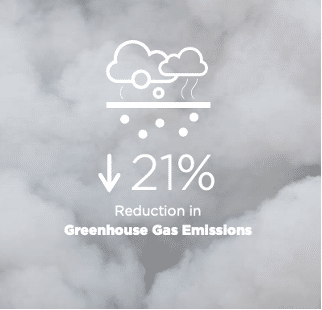As a cotton plant grows, it uses carbon dioxide during photosynthesis and can sequester 23% more carbon dioxide equivalent of greenhouse gas emissions (GHGs) than it emits. The U.S. cotton industry has worked for decades to improve the two primary sources of GHG emissions: energy use and nitrogen fertilizer.
Energy consumption includes the use of diesel fuel, electricity, and natural gases for tasks such as operating farm machinery, running irrigation systems, and ginning cotton. Energy is also used in the production, application and transportation of crop protection inputs which are used in the cotton growing process to target harmful pests, diseases, and fungi.
Release of emissions also occurs from natural processes in the soil which contribute to the release of various gases into the atmosphere such as nitrous oxide when nitrogen fertilizer is applied. However, it is important to recognize that these emissions are an integral part of the ecosystem’s functioning.
As one of the six key sustainability metrics for continuous improvement, the Trust Protocol annually measures energy-related emissions and CO2 emissions per pound of cotton lint associated with cotton production and ginning. Field-level data helps growers track energy use and adopt practices to help improve their environmental footprint. This includes utilizing more fuel-efficient equipment, practicing reduced tillage, adopting integrated pest management practices on an individual basis, the intentional use of inputs that are landscape specific, and planting cover crops to protect the soil and promote biodiversity. Precision agriculture techniques, such as GPS, are also used to optimize crop input application. Over time, these regenerative practices can increase productivity and naturally reduce the need for external inputs required for plants.
Results from the program’s 2022-23 data show that these practices have reduced GHG emissions by 21% relative to the 2015 baseline, putting the Trust Protocol on track to achieve its goal of a 39% decrease by 2025.

The Climate Smart Cotton Program, lead by the Trust Protocol, aims to further build on this success. As part of this five-year pilot, growers can learn, grow and explore new opportunities for reducing climate impacts, and are provided with resources to aid with implementation. The Climate Smart Cotton Program’s goal is to reduce CO2e emissions by 1.14 million metric tons through promoting the adoption of practices such as no-till, cover crops, and nutrient management to decrease GHG emissions, store more carbon and water in the soil, and improve soil and ecosystem function.
Learn more about the Trust Protocol and its efforts to improve GHG emissions here. To learn more about the other five environmental metrics and data, check out the 2023 annual report.




























































